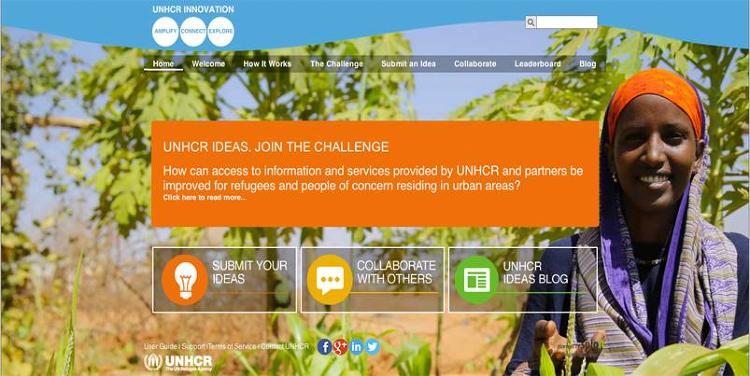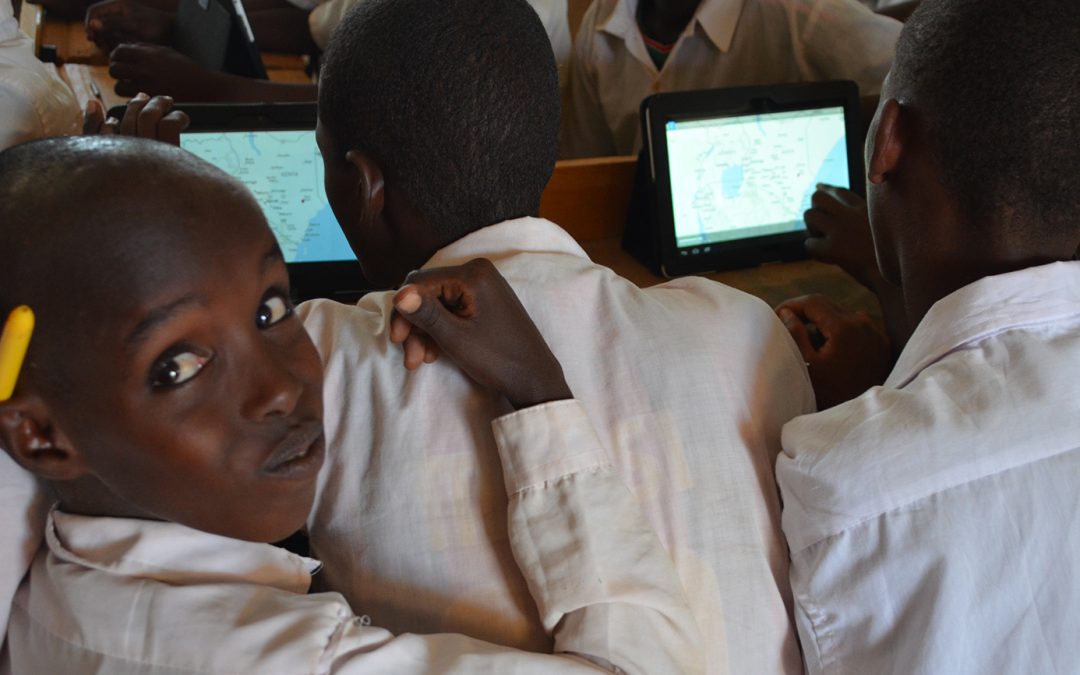Have you ever heard of the concept “the wisdom of the crowd”? It’s the idea that the collective opinion of a group of individuals is better than the opinion of one. Unfortunately, the decisions or ideas of one often shape business, societies, and nations in the world we live in today. Many of us have experienced that “Ah-ha!” moment where we thought we could do it better if someone would just listen.
I think this is why innovation crowdsourcing resonates with so many people. There is this bottom-up approach that creates a space in a large organization where an intern’s ideas will be weighed the same against the CEO.
Innovation crowdsourcing has been around for a while, and the private sector has had particular success in providing incentives and training to catalyze staff to engage and submit their ideas. We wanted to pilot this model at UNHCR to test and validate this approach for the humanitarian sector.
UNHCR Ideas is an online idea-management platform that enables people to come together and solve challenges that impact refugee and displaced communities. The platform is also being using by UNHCR colleagues to crowdsource solutions to challenges unique to their Division or Operation, or to gather innovative ideas, generate feedback, or form communities of practice.

- Screenshot of the original UNHCR Ideas platform in 2013.
Since the platform launched in August 2013, we’ve had 7 Challenges that have gathered over 430 ideas and 2,500 comments. Recently we launched the Social Media in Learning Challenge with UNHCR’s Global Learning Centre. The Challenge aims to identify how UNHCR’s Global Learning Centre can better leverage social media in their training and learning programs. If you’re interested you can add your ideas until January 12th, 2016.
So what happened to the ideas from our first Challenges? Below are three updates on winning ideas that have been taken forward by UNHCR as prototypes over the past two years.
Access to Information for Refugees Challenge
How can access to information and services provided by UNHCR and partners be improved for refugees and people of concern residing in urban areas?
Help.unhcr.org was selected as the winning idea of the very first UNHCR Ideas Challenge, which addressed the need for better access to information and services for refugees and persons of concern in urban areas. The idea proposes a simple, user-friendly,
and centrally maintained platform that delivers information to persons of concern about the services that are available to them in the host country. The website will comprise a wide variety of up-to-date information on office location, services, legal support, status determination, etc., based on their country of interest. Following the selection of the winning idea, multiple focus groups were held to understand the needs and expectations that persons of concern had for the website.
Through understanding the desires of persons of concern in accessing information, UNHCR developed a collaborative approach where persons of concern were involved in all stages of the project design. Three website designs were created and presented to participants of the focus groups, who were asked to rank them and provide feedback. The most preferred design was selected in July 2014, and reflected the opinion that it was simple, easy to use, and intuitive for users.
UNHCR Costa Rica officially launched the beta version of help.unhcr.org in March 2015, simultaneously with a larger communications campaign run by UNHCR Innovation Fellow, Valentina Duque, Durable Solutions Associate based in San Jose, Costa Rica. Help.unhcr.org highlights the success of involving persons of concern at all stages of the innovation process – from the identification of the challenge, to evaluation and the creation of a user-centred solution.
Now the operation is looking at ways to sustain, scale and improve the product with new innovative tools.
One of the tools they’re testing is a prototype of a stand-up tablet that will be placed at the borders of Costa Rica. An offline version of help.unhcr.org will be uploaded to the tablets to immediately provide refugees with reliable information on asylum claim procedures and support programs. Click here for more information on the project and stay tuned for more updates.
Language Barrier Challenge
How can better opportunities be provided for refugees to learn and use a new language, both in school and in their daily lives?
In April 2014, we announced the winner of the Ikea Foundation sponsored Challenge focused on overcoming language barrier. The winning idea, “UNHCR Tablets for Education” proposes loading tablets with educational applications, videos and audio recordings to help children better interact with a second language.
The effectiveness of utilizing tablets for educational purposes in a refugee context is currently being tested by the Learn Lab through the Instant Network Schools and Ideas Box programs. However, these solutions do not directly focus on second language acquisition. The winning idea emphasizes language acquisition as an essential tool in the orientation of refugees to a new country, and will combine blended learning between traditional and information technology learning opportunities.
Prior to testing, UNHCR Innovation and the Education Unit commissioned a detailed review of available language learning apps. We contracted Dr. Martha Ferede to develop a report on the use of Android tablets in refugee camps and out-of-school contexts as tools to support language learning and retention. The idea was submitted by Ioannis Papachristodoulou, a Senior IT Assistant based in Athens Greece. Ioannis will develop the idea as a UNHCR Innovation Fellow in 2015. He has so far identified refugee transit centres and other potential areas for testing. UNHCR Innovation initiated conversations with numerous partners to identify assumptions for testing and logistic models for application in the refugee context.
Greece was selected as an initial testing site to provide the opportunity for language acquisition outside the traditional classroom model. As the closest access point to Western Europe, thousands of refugees travel to Greece before asylum procedures can be processed in neighboring countries or regions. “Tablets for Education” will be delivered as a program for young refugees and displaced persons at transit centres where they begin the integration process into Europe, and are eager to strengthen their language skills. The first prototype of “Tablets for Education” was tested in Greece in 2015, while simultaneous testing within Instant Network Schools will begin after the initial test. Refinement and scaling of the “Tablets for Education” model will be aligned with the continuation of Ioannis’ Fellowship project moving forward.
#EducateGirls Challenge
How can we support communities and educators to overcome the challenges faced by adolescent girls in accessing education?
“TIGER – These Inspiring Girls Are Reading” was selected as the winning idea for the #EducateGirls Challenge in early 2015. The TIGER program empowers adolescent girls in the Za’atari refugee camp in Jordan, many who are currently not in school, to improve their literacy and socials skills, and enabling many of them to complete their secondary education. Following extensive research by the Challenge sponsor, the Open Learning Exchange, Inc. (OLE), the OLE team recently traveled to the field to meet with implementing partners, and the community to discuss their idea.
The pilot program was launched in November 2015 and allows participating adolescent girls to enjoy access to a virtually unlimited library of open educational resources. Since the winning idea was chosen, 11 Syrian women have been trained as Coaches and Tech Geniuses to lead the TIGER program and enroll girls within the camp. The Za’atari refugee camp is hosting six TIGER centers, each comprising of a Coach and Tech Genius, within multiple community centers.
The TIGER program hopes to demonstrate and document the effectiveness of an innovative and community-based approach that will enable adolescent girls in the Za’atari to increase their sense of agency, meaning and connection, and ultimately leading them to complete at least their secondary education.
The approach is based on strong local leadership, open education resources, continuous user feedback and the consideration of local capacities to create self-sustainable learning. TIGER will continue to be tested and refined over the coming months, with the hopes that the pilot will move to a sustainable solution beyond this first year.
Photo credit: UNHCR/B. Sokol
We’re always looking for great stories, ideas, and opinions on innovations that are led by or create impact for refugees. If you have one to share with us send us an email at [email protected]
If you’d like to repost this article on your website, please see our reposting policy.

